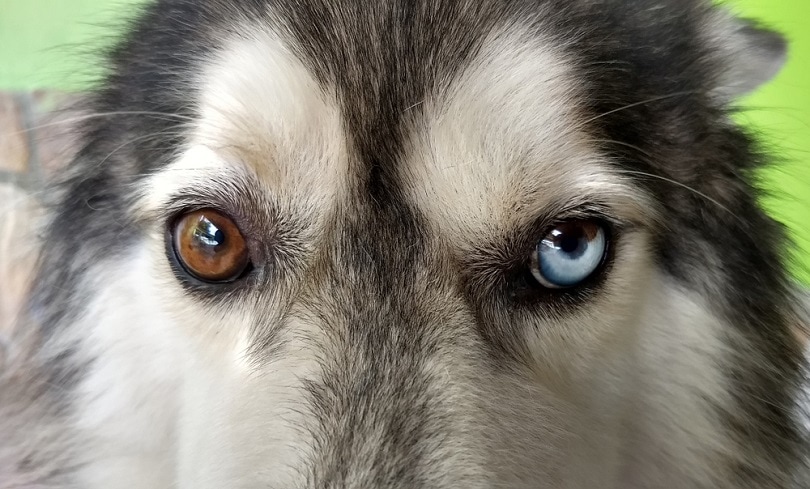
If you’ve ever noticed a puppy with two differently colored eyes, you are surely wondering what may cause this stunning phenomenon. This unique and rare condition is called heterochromia, and it is hereditary, meaning it is passed from the puppy’s parents onto the puppy, causing one or both irises to lack melanin. This is manifested in the form of two entirely different eye colors, one eye with two different colors or speckles in the iris.
While this idea may astound you, knowing that this condition doesn’t affect your dog’s health is crucial. Nevertheless, certain conditions appear similar to heterochromia but are not inherited and are instead caused by serious illnesses or trauma.
Read the article below to find out what exactly heterochromia is, how it occurs, and how it affects your dog.
What is Heterochromia?
Heterochromia is a rare condition that occurs in humans but more often in animals such as dogs, cats, and even horses. It is usually harmless to the puppy and occurs due to variations in the amount of melanin pigment in the iris. Puppies that have inherited this feature from their parents will begin showing symptoms when they are about 4 weeks old, when the final colors of the eye develop. While there may be many myths surrounding this condition, the fact is that genetics is the reason for its occurrence unless it is a consequence from a previous eye problem.1
The color of the eyes is dependent on the amount of melanin (pigment) in the iris. Dogs with brown eyes have a large amount of melanin in the iris, while dogs with blue eyes have much less of this pigment. Heterochromia is mostly visible in dogs’ iris because dogs usually have a high amount of melanin in their eyes, resulting in dark brown colored eyes. Eye and coat color are inherited. The merle pattern is a distinctive coat color of dogs, which can sometimes be associated with heterochromia. The merle gene has been associated with deafness and certain severe eye diseases, so affected dogs should be genetically tested if mating is desired.2

Types of Heterochromia by Cause
Depending on the cause of heterochromia, this condition has two types: inherited and acquired.
- Inherited Heterochromia: Puppies are born with this characteristic and it is not a health problem. Their vision is not impaired.
- Acquired Heterochromia: Occurs at any point in a dog’s life. Some type of trauma, inflammation of the eye, auto-immune diseases, cancer, or ocular bleeding disorders, usually causes it.
Types of Inherited Heterochromia
There are three types of inherited heterochromia by the way it appears in your dog’s eyes.
- Complete Heterochromia: This type of heterochromia is characterized by two eyes that are completely different in color. A dog can have one entirely blue and one entirely brown iris.
- Central Heterochromia: This type of heterochromia is characterized by the central area of the iris differentiating in color from the rest of the iris. Usually, the circle surrounding the pupil will have a different color, often flaring out in spikes towards the outer area of the iris.
- Sectoral Heterochromia: Sectoral heterochromia will result in an iris of one eye having two or more colors. This will appear in darker dotting, geometric splits, or marbling in different shades than the primary color.
Most Common Breads with Heterochromia
Heterochromia occurs more often in some breeds, while certain dog breeds are rarely affected by this condition. Heterochromia will usually affect dogs that have a lot of white in their fur, especially around their head. White fur is another type of pigment mutation, and most dogs will usually have dark black, brown, or golden fur.
Does Heterochromia Affect the Health of Your Dog?
While many people believe that dogs with different colored eyes have many health problems, we are here to break that myth. If your puppy has had heterochromia since it was born, this condition is considered to be inherited. Inherited heterochromia cannot affect your dog’s health, and its vision will be entirely normal.
On the other hand, if your dog develops heterochromia later in life, it is probably caused by some underlying condition. Trauma, inflammation, immune-mediated problems, glaucoma or eye tumors can cause one eye to have a different, unusual discoloration. It is essential to differentiate heterochromia caused by a severe illness from harmless, inherited heterochromia. Noticing signs of blindness or eye conditions as soon as possible can help you find the correct diagnosis and treatment in time.

Conclusion
Heterochromia is a feature that you should not worry about and that your puppy inherited from its parents. This characteristic cannot hurt your puppy’s overall health and often has a uniquely beautiful appearance. This type of pigment absence can be manifested in many ways, including discoloration of the dog’s fur. If your dog’s eyes change color suddenly contact your vet as soon as possible since this can be a sign of severe eye disease. While your puppy born with heterochromia will seem unique, knowing what is occurring in its body is necessary.
Featured Image Credit: Shyjo, Shutterstock







